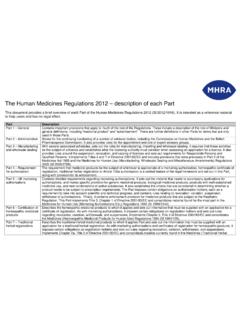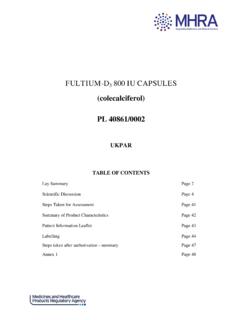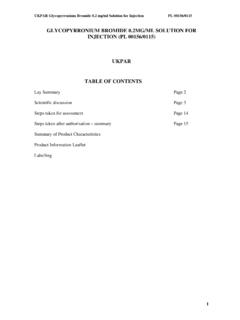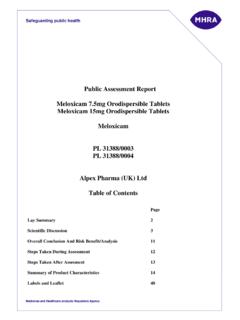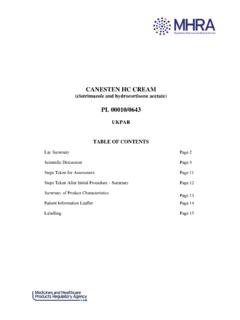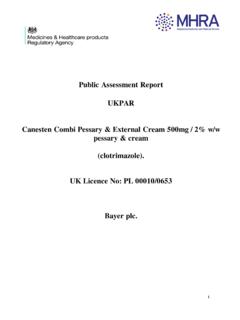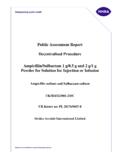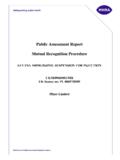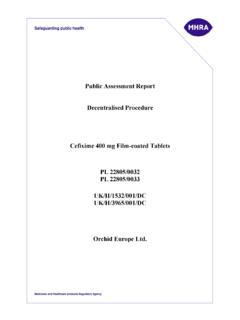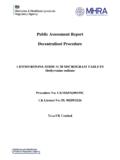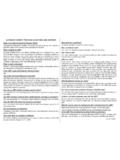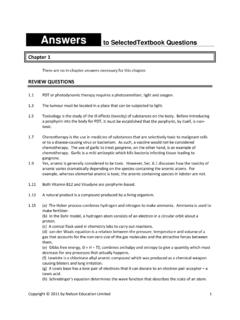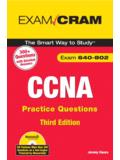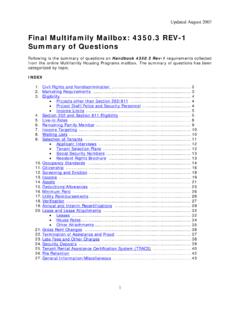Transcription of MHRA Questions and Answers for Specials manufacturer’s
1 MHRA Questions and Answers for Specials manufacturer s 1. Introduction & Purpose 2. Scope 3. Q & As 4. Glossary 5. Reference documents 6. Revision History 1 INTRODUCTION & PURPOSE The purpose of this document is to provide guidance for Manufacturing Specials (MS) licence holders in the interpretation of the GMP requirements to be applied when manufacturing unlicensed medicines. Questions and Answers have been used to promote easy updates when further clarification on specific topics is required. The document includes guidance on the appropriate standards for the manufacture of aseptically prepared products under an MS licence using essentially closed systems. However it is important to recognise that all aseptically prepared products where open systems are used, should be manufactured in accordance with the standards outlined in the EU Guide, specifically Annex 1.
2 This Q&A does not replace any of the requirements for unlicensed medicines already contained in Guidance Note 14 (GN 14). 2 SCOPE The guidance in this document is for the manufacture of products under an MS licence. It is not intended to cover the importation of unlicensed products although many of the expectations are common. The general guidance within this document will also apply to radiopharmaceuticals. This document does not contain any guidance relating to Advanced Therapy Medicinal Products which came into operation in December 2008 in accordance with European regulation No 1394/2007. 3 Q & As Quality Management What is the expectation for the preparation of a Product Quality Review (PQR) for MS manufacturers ? Given the range of products produced, the absence of a Marketing Authorisation and, in general, the limited batch sizes manufactured there is no mandatory requirement for MS manufacturers to produce a PQR.
3 MHRA Questions and Answers for Specials manufacturer s Version1 20/9/13 2 However there are benefits in conducting a regular periodic quality review at a justified frequency incorporating the relevant PQR elements in chapter 1 of the EU GMP guide. This approach is strongly recommended where numerous batches of the same product are manufactured. What are expectations regarding data trending? The minimum expectation is that trending will be conducted for environmental monitoring, complaints and deviations. Trending for environmental monitoring should be carried out monthly to indicate whether organisms detected are in line with those previously found or whether there has been a shift in the type of organisms detected. An annual summary review should also be undertaken What is the minimum expectation for capacity planning? A capacity plan should be in place, to ensure adequate resourcing for the expected demand.
4 There should be a thorough understanding of production demand and supply constraints, and appropriate strategies to highlight imbalances in a timely manner to effect appropriate action. Capacity plans should also address ancillary tasks such as maintenance of the quality management system (QMS). The capacity plan should be reviewed at least annually or when there are significant changes to supply and demand. Any changes should be recorded in the change control system. What is the basis for the formulation of an unlicensed medicine? See Human Medicines Regulations section 167 for full details. The product formulation must be in line with the order supplied. MHRA Questions and Answers for Specials manufacturer s Version1 20/9/13 3 In cases where the order does not adequately describe the formulation, this may be determined by the manufacturer, and where necessary, should be confirmed with the customer.
5 The product formulation should be derived by personnel appropriately qualified and experienced to do so. Typically, this would be a scientist who meets similar education criteria for the person responsible for QC [ a relevant life sciences degree and relevant post-qualification experience in formulation (typically 3 years) although an applicant does not have to be eligible to be a QP] The formulation must be independently checked against the requirements of the order, and must verify that the formulation is suitable for the intended route of administration. The formulation check may incorporate a clinical check; however there is no GMP requirement to do so. The product should comply with the requirements of the British Pharmacopoeia (BP) in cases where there is a published monograph. What format is allowable for the order received?
6 Initiation of the order may be by telephone, however this should be followed up by a written (faxed or email) confirmation from the customer to be used as part of the final release check. Computer ordering systems providing the same level of assurance are also acceptable. Manufacture of a product may be carried out in anticipation of an order. batches are manufactured based on the known future demand for a product. The product must be in compliance with the original order. Any proposed changes from the requirement of the original order must result in receipt of a new order. Batch Release (see also for persons who can perform release) The order must be available in a written format (fax, mail, email) at the time of product release. An order can be received externally for an individual patient or internally to manufacture a batch for stock replenishment.
7 MHRA Questions and Answers for Specials manufacturer s Version1 20/9/13 4 For external orders: Batch release must include an independent check against the original order. It is essential that the final product release includes a physical check against the product to be dispatched including any secondary labelling that is applied. For internal orders (batches manufactured in advance): release may be against a specification or equivalent document in anticipation of supply. In this case the release should include verification that the QC testing results comply with the specification for those batches which are manufactured from API and excipients. Is retrospective product release acceptable? Product release is a real-time activity; any subsequent review of batch documentation should be viewed as a quality review tool, but not considered to be a component of the release process for a given batch.
8 Pharmacovigilance The requirements relating to suspected adverse reactions are such that: Any person who sells or supplies a relevant medicinal product shall maintain, and keep for a period of at least five years; a record showing details of any suspected adverse reaction to the product sold or supplied. This applies to not only manufacturers , importers and distributors but also pharmacists, doctors, dentists, independent prescribers etc. The person required to maintain the records mentioned in the above paragraph shall:- Notify the licensing authority of any suspected or serious adverse reaction; And make available for inspection at all reasonable times by the licensing authority, records mentioned in the above paragraph. See section of the Good Pharmacovigilance Practice Guide. MHRA Questions and Answers for Specials manufacturer s Version1 20/9/13 5 What impact will the revised chapter 1 have on MHRA expectations?
9 The revised chapter 1 provides more detail on expectations for deviations. As per xv and , it is expected that there is a robust deviation process in place which documents the issue, applies immediate corrective action but also in addition, identifies the most likely or probable root cause to prevent re-occurrence. Once the root cause is identified, it is expected that there is a CAPA system in place which can be either included or separate from the deviation itself. Deviations where the same issue reoccurs over a period of time and are not addressed are indicative of a weak deviation process and will be cited under chapter 1. The role and responsibility of senior management to ensure that the quality system is effective is defined in section and evidence of their involvement through attendance at quality meetings would be expected during inspections.
10 Senior management would include those who are named on a manufacturing authorisation and the head of the Pharmacy unit. Any serious quality issues would also be expected to be notified to the Chief Executive of the Trust. Personnel Who can perform delegated batch release? What should be their qualifications? A releasing officer should typically have at least 2 years post-qualification relevant GMP experience. Anyone who has received appropriate training (relevant to the manufactured dosage forms) may perform batch release, provided they are approved by the person responsible for QC. Typically, these persons will hold a recognised qualification in a Pharmacy or related subject and have the appropriate experience. Releasing officers should be named within the Quality System, and be approved for batch release activities by the person named on the license for QC.
